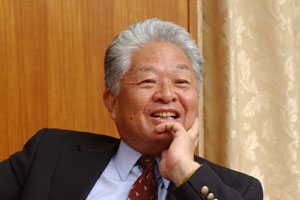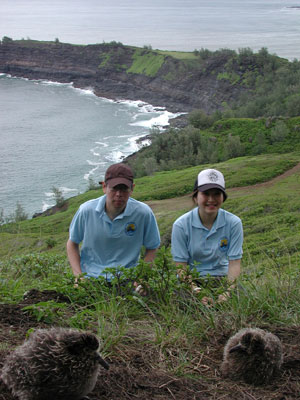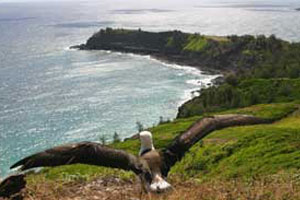Message
Message of 20061001
Comeback for the Albatross

In the Japanese language the albatross is known as ahohdori. 'Ahoh' means "stupid" and 'dori' means bird, so 'ahohdori' literally means stupid-bird.
It seems the reason for this rather disgraceful name is related to the circumstances surrounding its near extinction. At the end of 19th century people moved from Hachijo Island, located almost 300Km south of Tokyo, to Trishima Island, about 300Km further south. There they killed Short-tailed Albatross Diomedea albatrus in large numbers, and used their feathers to stuff quilts. The bird was apparently named ahohdori because it didn't fly away, even when confronted by the sight of its fellow birds being killed.
Back in 1930, Dr. Yoshimaro Yamashina, the founder of our Institute, studied the albatross on Torishima Island. He found small groups on flat sandy areas near this island's mountain top and on a lower area where Japanese silver grass grew. According to this report, there were about 2,000 adult birds and less than 200 chicks. Dr. Yamashina proposed immediate conservation action. Regrettably, the excessive hunting continued, and the birds declined further until they were considered globally extinct 60 years ago.
However, a small number of breeding albatross was noticed in Torishima and Senkaku islands in 1951 and 1971 respectively. This time research and conservation efforts were put into action by Prof. Hasegawa of Toho University. Silver grass was planted at the breeding site and this successfully reduced the flow of sand and water on the cliff. The number of albatross has increased little by little, and today there are as many as 2,000 individuals.
In 1991 a "decoy campaign" was launched at Hatsunezaki, Torishima. The tactics were to place decoys and play a tape of the bird's voice on a gentle slope where the birds used to breed. Young birds were lured there, and in time created a new colony on this more suitable area. The Yamashina Institute for Ornithology, with its longstanding relationship with the albatross, has been working on this project. This spring, 13 chicks made their flight from the colony.
Torishima is a volcanic island, which could erupt anytime. Researchers urgently wanted to see another colony established on a non-volcanic island. At the same time, the United States started to address the issue of the albatross bycatch in the fishing areas of Alaska, where the albatross passes during migration.
It seemed obvious for the US and countries like Japan, where the birds breed, to work in cooperation. Thus the albatross recovery team was organized with specialists from US, Australia and Japan.
The team has said that the short-tailed albatross may be delisted from Red Data Book under the following conditions.
1. The total breeding population of the birds reaches a minimum of 1,000 pairs; and
2. The 3-year running average growth rate of the population as a whole is > 6% for > 7 years; and
3. A total of at least 250 breeding pairs exist on at least 2 non-volcanic islands; and
4. A minimum of 10 percent of these (i.e., > 25 pairs) occur on a site or sites other than the Senkaku Islands.

Japanese researchers are fledging chicks of Laysan Albatross on Kauai Island, Hawaii.
(left:Deguchi Tomohiro and right:Harada Tomoko)
Some interesting initiatives are taking place. For example Dr. Tomohiro Deguchi of the Yamashina Institute succeeded in breeding Laysan Albatross in Kauai, Hawaii in 2006. Now the plan is to artificially breed chicks of the Black-footed Albatross on the Ogasawara islands in 2007. After these trials, it is planned finally to move some Short-tailed Albatross chicks from Torishima to Ogasawara as early as possible, to get them to establish a new colony there.
Another great area of interest as far as albatross are concerned is the Senkaku Islands. These islands are the centre of major political considerations but the albatross recovery group would like to see ornithologists from China and Japan being allowed to research the albatross there. On the other hand numbers of albatross on the Senkaku islands do seem to be increasing steadily at present. Perhaps the lack of any human intervention on the islands has been good for them.
To examine these issues further the Yamashina Institute held a symposium in Tokyo in September 2006.
We hope that now is the time for the "stupid" bird to make a comeback.

An artificially-raised immature Laysan Albatross takes off
(Photo by Lindsay C. Young)
(From the Quarterly Newsletter of BirdLife in Asia, Vol.5, No.4)

